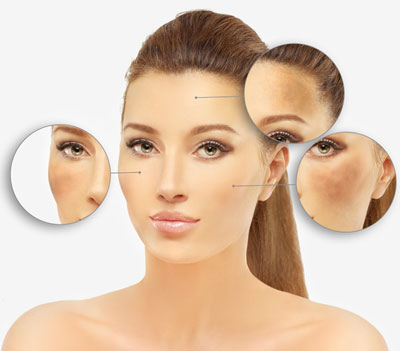What is Skin Pigmentation?
Skin pigmentation is the result of an imbalance in melanin production. Melanin is synthesized by melanocytes, the specialized cells in the skin's stratum corneum. Genetic predisposition, phlogistic changes, ultraviolet light exposure, and trauma to the skin interrupt this process, resulting in different types of pigmentation problems. These disorders are classified as:-
Hyperpigmentation
This condition results from an excess of melanin, causing dark patches or spots on the skin. Common types include:-
- Melasma - Melasma is frequently induced by hormonal shifts, e.g., pregnancy and oral contraceptive use and manifests as symmetrical brown spots on the face.
- Sunspots (Solar Lentigines) - Due to cumulative sun exposure, these flat, dark macules are often seen on sun-exposed areas such as the face, hands, and shoulder.
- Post-Inflammatory Hyperpigmentation (PIH) - Dark spots that develop after skin injuries, acne, or inflammation.
Hypopigmentation
This condition occurs when melanin production decreases, leading to lighter patches of skin. Examples include vitiligo and albinism.
Causes of Pigmentation
Detection of the underlying pigmentation plays a key role in successful therapeutic strategies. Key factors include:-
Sun Exposure
- UV radiation stimulates melanin production as a defence mechanism. Repeated exposure can cause sunspots and skin pigment irregularity.
Hormonal Changes
- Melasma and other Hyperpigmentation disorders can be induced by the following pathological states such as pregnancy, menopause, or hormonal medications.
Skin Trauma
- Irritation, burns, acne or aggressive skin treatments provoke post-inflammatory.
Hyperpigmentation
Genetics
- A familial history of pigmentation disorders raises the risk of developing corresponding disorders.
Aging
- With skin ageing, melanin synthesis regulation decreases and thus age spots and pigmentation irregularities occur.
Diagnosis of Pigmentation
The accurate diagnosis of the pigmentation type and degree is of great significance. At our skin clinic, we use advanced diagnostic tools, including:-
- Wood's Lamp Examination - Detects underlying pigmentation problems, persisting in the human eye.
- Dermatoscopy - Gives an extensive view of the skin strata and patterns of pigmentation.
- Skin Biopsy - In rare cases, a sample may be taken to rule out underlying conditions.


